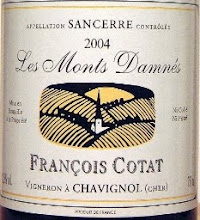Yes, that's the question I asked myself when we finished our latest blind tasting. I'm not sure why and how we came up with that theme, maybe we were drunk or high at the time but we decided to taste blind some Russian River Valley pinots against some Sonoma Coast pinots.
Well you heard it all: cool regions, micro-climate bla bla bla... This is total BS. It might be a cool climate if you compare it to Namibia but when you actually drink those wines, there's absolutely nothing cool about it.
Now I know I should not generalize with only the 5 bottles we had during the tasting but this goes beyond this tasting. Hardly do I remember any pinot from those AVAs that gave me goose bumps.
Anyway, we tasted blind the following 5 pinots:
1998 Martinelli, Martinelli Vineyard - Russian River Valley
Pale cherry core, hazy. Pretty nose with tobacco, red cherry and strawberry along earthy and light licorice notes.Full body, ripe fruits on the palate which matches the nose with additional violet notes. Coarse, some heat on the finish.
2008 Rivers-Marie - Sonoma Coast
Very ripe nose: cherry and a mix of quetsch and prunes. Med body, round and again those very ripe fruits on the palate. Very candy like. Really boring right now and is more similar to a cheap syrah (not shiraz) than a pinot noir.
2006 Freeman - Sonoma Coast
Lighter color than the Rivers Marie. Started pretty well with some enjoyable red cherry (also clafouti), herbs and licorice notes. Balanced, interesting cassis leaf notes. But with air, it became heavy with a sweet fruit in a wine lacking acidity. Another pass...
2005 Joseph Swan, Saralee's vineyard - Russian River Valley
Med cherry core. Smoke, grenadine and cherry, blood orange with a touch of oak and plum. Med body, round, balanced, good acidity. More dark cherry but the fruit is a little candied. Some heat on the tart finish. While OK and not over the top, this is boring and too easy. Based on this bottle, I don't see this bottle age very long.
2007 Merry Edwards - Sonoma Coast
Well, good I knew we were tasting pinot here cause it smells everything but pinot. Oh, and the palate as well. I was shocked to see this was Edwards. I always read good things on her, but this bottle was everything I don't want in my pinot. Oh well...
The verdict was clear for all of us: a big disappointment.
We had pretty big names of none of those pinot showed something attracting, at least to us.
Where is the sense of place? terroir? elegance? class?
It looks as the producer is definitely more important than if your pinot is from Sonoma Coast or RRV. They all show sweet fruit, lack acidity,
Among those 5, the Swan and Martinelli showed an interesting nose but then over ripe palate. The Swan being the only wine below 14%...
Well, let's go back to Burgundy, and fast!








